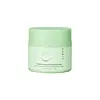What's inside
What's inside
 Key Ingredients
Key Ingredients

 Benefits
Benefits

 Concerns
Concerns

 Ingredients Side-by-side
Ingredients Side-by-side

Water
Skin ConditioningGlycerin
HumectantUrea
BufferingNiacinamide
SmoothingXylitylglucoside
HumectantAnhydroxylitol
HumectantXylitol
HumectantPolyacrylate Crosspolymer-6
Emulsion StabilisingPanthenol
Skin ConditioningAloe Barbadensis Leaf Extract
EmollientLecithin
EmollientSodium Acrylates Copolymer
Phenoxyethanol
PreservativeCentella Asiatica Extract
CleansingSodium Cocoyl Amino Acids
CleansingSarcosine
Skin ConditioningPotassium Aspartate
Skin ConditioningMagnesium Aspartate
Skin ConditioningDisodium EDTA
Acacia Senegal Gum
MaskingXanthan Gum
EmulsifyingHyaluronic Acid
HumectantWater, Glycerin, Urea, Niacinamide, Xylitylglucoside, Anhydroxylitol, Xylitol, Polyacrylate Crosspolymer-6, Panthenol, Aloe Barbadensis Leaf Extract, Lecithin, Sodium Acrylates Copolymer, Phenoxyethanol, Centella Asiatica Extract, Sodium Cocoyl Amino Acids, Sarcosine, Potassium Aspartate, Magnesium Aspartate, Disodium EDTA, Acacia Senegal Gum, Xanthan Gum, Hyaluronic Acid
Water
Skin ConditioningPropylheptyl Caprylate
EmollientGlycerin
HumectantPolyacrylate Crosspolymer-11
Emulsion StabilisingNiacinamide
SmoothingPropanediol
SolventPentylene Glycol
Skin ConditioningC15-19 Alkane
SolventDiheptyl Succinate
EmollientCapryloyl Glycerin/Sebacic Acid Copolymer
Skin ConditioningBifida Ferment Lysate
Skin ConditioningInulin
Skin ConditioningErythritol
HumectantC12-15 Alkyl Lactate
EmollientGluconolactone
Skin ConditioningSodium Benzoate
MaskingTrehalose
HumectantBetaine
HumectantAcetyl Glucosamine
Skin ConditioningCeramide NP
Skin ConditioningCeramide AP
Skin ConditioningGlycosphingolipids
EmollientHydrogenated Lecithin
EmulsifyingTetraacetylphytosphingosine
Skin ConditioningCholesterol
EmollientStearic Acid
CleansingXanthan Gum
EmulsifyingCaprylic/Capric Triglyceride
MaskingGlyceryl Stearate
EmollientCetearyl Alcohol
Emollient1,2-Hexanediol
Skin ConditioningPhytosteryl/Octyldodecyl Lauroyl Glutamate
Skin ConditioningBeta-Glucan
Skin ConditioningCaprylyl Glycol
EmollientAvena Sativa Kernel Extract
AbrasiveTocopheryl Acetate
AntioxidantSodium Gluconate
Skin ConditioningPolyacrylate Crosspolymer-6
Emulsion StabilisingSodium Hyaluronate
Humectant3-O-Ethyl Ascorbic Acid
Skin ConditioningSodium Hydroxide
BufferingWater, Propylheptyl Caprylate, Glycerin, Polyacrylate Crosspolymer-11, Niacinamide, Propanediol, Pentylene Glycol, C15-19 Alkane, Diheptyl Succinate, Capryloyl Glycerin/Sebacic Acid Copolymer, Bifida Ferment Lysate, Inulin, Erythritol, C12-15 Alkyl Lactate, Gluconolactone, Sodium Benzoate, Trehalose, Betaine, Acetyl Glucosamine, Ceramide NP, Ceramide AP, Glycosphingolipids, Hydrogenated Lecithin, Tetraacetylphytosphingosine, Cholesterol, Stearic Acid, Xanthan Gum, Caprylic/Capric Triglyceride, Glyceryl Stearate, Cetearyl Alcohol, 1,2-Hexanediol, Phytosteryl/Octyldodecyl Lauroyl Glutamate, Beta-Glucan, Caprylyl Glycol, Avena Sativa Kernel Extract, Tocopheryl Acetate, Sodium Gluconate, Polyacrylate Crosspolymer-6, Sodium Hyaluronate, 3-O-Ethyl Ascorbic Acid, Sodium Hydroxide
Ingredients Explained
These ingredients are found in both products.
Ingredients higher up in an ingredient list are typically present in a larger amount.
Glycerin is already naturally found in your skin. It helps moisturize and protect your skin.
A study from 2016 found glycerin to be more effective as a humectant than AHAs and hyaluronic acid.
As a humectant, it helps the skin stay hydrated by pulling moisture to your skin. The low molecular weight of glycerin allows it to pull moisture into the deeper layers of your skin.
Hydrated skin improves your skin barrier; Your skin barrier helps protect against irritants and bacteria.
Glycerin has also been found to have antimicrobial and antiviral properties. Due to these properties, glycerin is often used in wound and burn treatments.
In cosmetics, glycerin is usually derived from plants such as soybean or palm. However, it can also be sourced from animals, such as tallow or animal fat.
This ingredient is organic, colorless, odorless, and non-toxic.
Glycerin is the name for this ingredient in American English. British English uses Glycerol/Glycerine.
Learn more about GlycerinNiacinamide is a multitasking form of vitamin B3 that strengthens the skin barrier, reduces pores and dark spots, regulates oil, and improves signs of aging.
And the best part? It's gentle and well-tolerated by most skin types, including sensitive and reactive skin.
You might have heard of "niacin flush", or the reddening of skin that causes itchiness. Niacinamide has not been found to cause this.
In very rare cases, some individuals may not be able to tolerate niacinamide at all or experience an allergic reaction to it.
If you are experiencing flaking, irritation, and dryness with this ingredient, be sure to double check all your products as this ingredient can be found in all categories of skincare.
When incorporating niacinamide into your routine, look out for concentration amounts. Typically, 5% niacinamide provides benefits such as fading dark spots. However, if you have sensitive skin, it is better to begin with a smaller concentration.
When you apply niacinamide to your skin, your body converts it into nicotinamide adenine dinucleotide (NAD). NAD is an essential coenzyme that is already found in your cells as "fuel" and powers countless biological processes.
In your skin, NAD helps repair cell damage, produce new healthy cells, support collagen production, strengthen the skin barrier, and fight environmental stressors (like UV and pollution).
Our natural NAD levels start to decline with age, leading to slower skin repair, visible aging, and a weaker skin barrier. By providing your skin niacinamide, you're recharging your skin's NAD levels. This leads to stronger, healthier, and younger looking skin.
Another name for vitamin B3 is nicotinamide. This vitamin is water-soluble and our bodies don't store it. We obtain Vitamin B3 from either food or skincare. Meat, fish, wheat, yeast, and leafy greens contain vitamin B3.
The type of niacinamide used in skincare is synthetically created.
Learn more about NiacinamidePolyacrylate Crosspolymer-6 is a texture enhancer and pH adjuster.
It is be used to thicken water-based products and create a gel-texture with a velvet feel.
One manufacturer claims this ingredient to have a pH range of 2-8 and to be biodegradable.
Learn more about Polyacrylate Crosspolymer-6Water. It's the most common cosmetic ingredient of all. You'll usually see it at the top of ingredient lists, meaning that it makes up the largest part of the product.
So why is it so popular? Water most often acts as a solvent - this means that it helps dissolve other ingredients into the formulation.
You'll also recognize water as that liquid we all need to stay alive. If you see this, drink a glass of water. Stay hydrated!
Learn more about WaterXanthan gum is used as a stabilizer and thickener within cosmetic products. It helps give products a sticky, thick feeling - preventing them from being too runny.
On the technical side of things, xanthan gum is a polysaccharide - a combination consisting of multiple sugar molecules bonded together.
Xanthan gum is a pretty common and great ingredient. It is a natural, non-toxic, non-irritating ingredient that is also commonly used in food products.
Learn more about Xanthan Gum